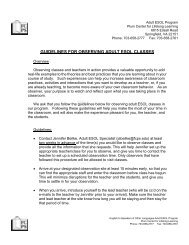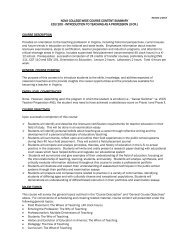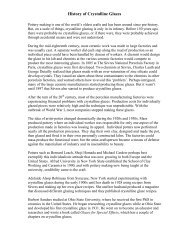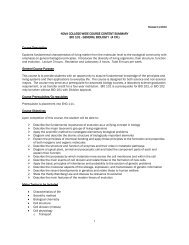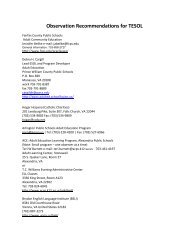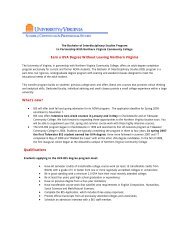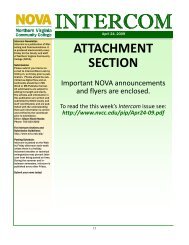The Case of the UNLABELED BOTTLES
The Case of the UNLABELED BOTTLES
The Case of the UNLABELED BOTTLES
Create successful ePaper yourself
Turn your PDF publications into a flip-book with our unique Google optimized e-Paper software.
<strong>The</strong> <strong>Case</strong> <strong>of</strong> <strong>the</strong> Unlabeled Bottles:<br />
Chemical Reactions/ Solubility Rules<br />
Goals<br />
1. To deduce <strong>the</strong> identity <strong>of</strong> five unknown solutions by comparison to reactions known solutions.<br />
2. To observe and predict reactions based on solubility rules.<br />
3. To practice writing balanced complete ionic and net ionic equations for chemical reactions.<br />
Introduction<br />
While Pr<strong>of</strong>. Nechita was putting away <strong>the</strong> materials from an experiment, she observed that five bottles <strong>of</strong><br />
aqueous solutions had lost <strong>the</strong>ir labels. By checking <strong>the</strong> inventory <strong>of</strong> chemicals used in <strong>the</strong> experiment, Pr<strong>of</strong> Nechita<br />
determined <strong>the</strong> names <strong>of</strong> <strong>the</strong> five chemicals. When Pr<strong>of</strong>. Nechita saw <strong>the</strong> list, she was able to set up a simple series <strong>of</strong><br />
experiments that would identify each <strong>of</strong> <strong>the</strong> unlabeled bottles using only <strong>the</strong> contents <strong>of</strong> <strong>the</strong> bottles.<br />
Pr<strong>of</strong>. Nechita now challenges you to identify as many <strong>of</strong> <strong>the</strong> five solutions as you can. You will take two identical<br />
sets <strong>of</strong> solutions. One with <strong>the</strong>ir proper labels in place (knowns) and <strong>the</strong> o<strong>the</strong>r set unlabeled (unknowns). In Part A, you<br />
will mix each <strong>of</strong> <strong>the</strong> known solutions toge<strong>the</strong>r (2 at a time) and observe what happens. Since you know <strong>the</strong> contents <strong>of</strong><br />
each bottle, you should be able to predict <strong>the</strong> results. Possible reactions include precipitation reactions, formation <strong>of</strong> a<br />
gas and production <strong>of</strong> heat. <strong>The</strong> results <strong>of</strong> <strong>the</strong>se reactions will be tabulated and used to identify <strong>the</strong> contents <strong>of</strong> <strong>the</strong><br />
unknowns.<br />
After performing <strong>the</strong> same experiments using unknown solutions in Part B, you should be able to determine <strong>the</strong><br />
identity <strong>of</strong> each <strong>of</strong> <strong>the</strong> unlabeled bottles by using <strong>the</strong> information you collected from Part A. (You will get <strong>the</strong> same<br />
results, just in a different order.) You will compare <strong>the</strong> results from mixing <strong>the</strong> known solutions with <strong>the</strong> results from<br />
mixing <strong>the</strong> unknown solutions to determine <strong>the</strong> proper labels for <strong>the</strong> unlabeled bottles.<br />
<strong>The</strong> three indicators <strong>of</strong> a reaction that you will be observing are<br />
a) <strong>the</strong> formation <strong>of</strong> an insoluble ionic solid (precipitate)<br />
b) <strong>the</strong> formation <strong>of</strong> a gas (H2CO3 decomposes to make H2O as a liquid and CO2 as a gas<br />
c) <strong>the</strong> change in <strong>the</strong> amount <strong>of</strong> heat (solution becomes hot or cold). When an acid reacts with a base, heat is produced<br />
Laboratory Activity<br />
Equipment: 10 test tubes test tube rack disposable plastic pipettes.<br />
Chemicals: <strong>The</strong> five “known” bottles with <strong>the</strong>ir names and concentrations (0.50 M CaCl2(aq) , 0.50 M Na2CO3(aq) ,<br />
0.50 M NaCl(aq), 0.50 M NaOH(aq), and 0.50 M H2SO4(aq) )<br />
Five “unknown” bottles (labeled as letters A-E).<br />
A. Reactions <strong>of</strong> Known Solutions<br />
1. Obtain and clean at least 10 test tubes (dry is not necessary). You do not need to label <strong>the</strong> test tubes!<br />
2. Place <strong>the</strong> test tubes in <strong>the</strong> rack in a pattern corresponding to <strong>the</strong> unshaded boxes in Table 1. Note that half <strong>of</strong> <strong>the</strong><br />
reactions are repeats and it is unnecessary to mix a solution with itself. <strong>The</strong>refore fill in only <strong>the</strong> parts <strong>of</strong> Table 1<br />
that are unshaded.<br />
3. Mix <strong>the</strong> appropriate known solutions toge<strong>the</strong>r following Table 1. Use <strong>the</strong> pipette provided or get a clean pipette for<br />
each different solution. Make sure that you do not use a pipette in more that one solution.<br />
4. Write down <strong>the</strong> result <strong>of</strong> <strong>the</strong> reaction that occurs (or NR for no reaction) in Table 1. Write ppt if a precipitate forms,<br />
gas if a gas is produced, heat if <strong>the</strong> solution become hotter, and cold if <strong>the</strong> solution becomes colder. Describing <strong>the</strong><br />
appearance <strong>of</strong> <strong>the</strong> products formed can help with <strong>the</strong> identification.<br />
5. Pour <strong>the</strong> waste down <strong>the</strong> sink. Clean and rinse <strong>the</strong> test tubes with deionized water.
B. Reactions <strong>of</strong> Unknown Solutions<br />
1. Clean <strong>the</strong> test tubes from Part I.<br />
2. Place <strong>the</strong> clean test tubes in a pattern following <strong>the</strong> unshaded boxes <strong>of</strong> Table 2.<br />
3. Mix <strong>the</strong> appropriate unknown solutions toge<strong>the</strong>r and write <strong>the</strong> results in Table 2.<br />
4. Dispose <strong>of</strong> <strong>the</strong> waste in <strong>the</strong> sink, rinse <strong>the</strong> test tubes and return <strong>the</strong>m to <strong>the</strong> box.<br />
5. Compare <strong>the</strong> reactions <strong>of</strong> <strong>the</strong> known solutions with <strong>the</strong> reactions <strong>of</strong> <strong>the</strong> unknowns. Use <strong>the</strong> comparison to<br />
identify <strong>the</strong> unlabeled bottles.<br />
Solubility Rules for CHM 111<br />
(recall that you begin with rule 1 and stop at <strong>the</strong> first rule that applies).<br />
1. All nitrate (NO3 − ) salts are soluble.<br />
2. All salts containing <strong>the</strong> alkali metal ions (especially Na + and K + ) or <strong>the</strong> ammonium (NH4 + ) ion are soluble.<br />
3. Most Cl − , Br − , and I − salts are soluble. Insoluble exceptions: Ag + , Pb 2+ and Hg2 2+ .<br />
4. Most sulfate (SO4 2− ) salts are soluble. Insoluble exceptions: PbSO4 , Hg2SO4, BaSO4, CaSO4, SrSO4<br />
5. Most hydroxide salts are only slightly soluble (mostly insoluble). <strong>The</strong> important soluble hydroxides are<br />
NaOH and KOH. <strong>The</strong> compounds Ba(OH)2, Sr(OH)2 and Ca(OH)2 are soluble at low concentration<br />
(
<strong>Case</strong> <strong>of</strong> <strong>the</strong> Unlabeled Bottles: Data Sheet Name ___________________________<br />
Part A: Known Solutions (Fill in <strong>the</strong> table with <strong>the</strong> results from your experimental observations: ppt, gas, heat etc.)<br />
CaCl2<br />
Na2CO3<br />
NaCl<br />
NaOH<br />
H2SO4<br />
CaCl2 Na2CO3 NaCl NaOH<br />
Report Page 1 <strong>of</strong> 2 Partner’s Name_____________________<br />
H2SO4<br />
Part B: Unknowns: (Fill in <strong>the</strong> table with <strong>the</strong> results from your experimental observations: ppt, gas, heat etc.)<br />
A<br />
B<br />
C<br />
D<br />
E<br />
A B C D<br />
Unknown A is _________________ Unknown B is _________________ Unknown C is _________________<br />
Unknown D is _________________ Unknown E is _______________<br />
E
<strong>Case</strong> <strong>of</strong> <strong>the</strong> Unlabeled Bottles: Post Lab Questions Name ___________________________<br />
1. How were you able to identify your unknowns? Explain clearly <strong>the</strong> logic.<br />
2. For every reaction that occurred (ignore NR) for <strong>the</strong> Unknown solutions, write down <strong>the</strong><br />
a) Balanced Molecular equation<br />
b) Complete ionic equation<br />
c) Net ionic equation<br />
Report Page 2 <strong>of</strong> 2



